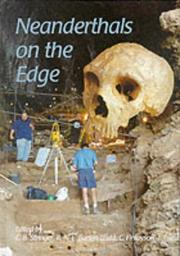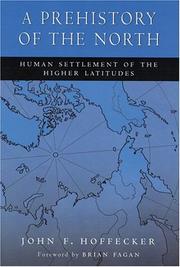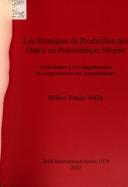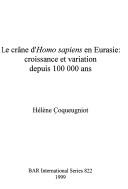Book
ISBN: 9781407360294 1407360299 Year: 2024 Publisher: Oxford : British Archaeological Reports,
Abstract | Keywords | Export | Availability | Bookmark
 Loading...
Loading...Choose an application
- Reference Manager
- EndNote
- RefWorks (Direct export to RefWorks)
This text provides ground-breaking research on Neanderthal lithic technical & subsistence practices. It examines bioclimatic settlement behavioural patterns of two regions of the Iberian Peninsula during the late Pleistocene Period: the northern Cantabrian region & the southern Betic region. The principal aim is to test whether hominid groups of the same species (Homo neanderthalensis) behaved, exploited & occupied their territory in similar or different ways under varying environmental conditions. Three approaches were undertaken: a technological study of eight lithic assemblages, a construction of a database of faunal remains & an analysis of settlement patterns related to bioclimatic mapping. Results of these analyses suggest that Neanderthals in both regions reacted to changes in local ecology & climate in similar ways, highlighting their great adaptive ability & commonality in their responses.
Homme de Néanderthal --- Neanderthals --- Homme de Néanderthal
Book
Abstract | Keywords | Export | Availability | Bookmark
 Loading...
Loading...Choose an application
- Reference Manager
- EndNote
- RefWorks (Direct export to RefWorks)
BELGIQUE, ESPACE GEOGRAPHIQUE --- NAMUR, PROVINCE --- SPY (BELGIQUE) --- HOMME DE NEANDERTHAL
Book
Abstract | Keywords | Export | Availability | Bookmark
 Loading...
Loading...Choose an application
- Reference Manager
- EndNote
- RefWorks (Direct export to RefWorks)
Homme prehistorique --- Homo erectus --- Homme de neanderthal --- Art prehistorique

ISBN: 1842170155 9781842170151 Year: 2000 Publisher: Oxford : Oxbow Books,
Abstract | Keywords | Export | Availability | Bookmark
 Loading...
Loading...Choose an application
- Reference Manager
- EndNote
- RefWorks (Direct export to RefWorks)
Neanderthals --- Homme de Néanderthal --- Congresses. --- Congrès --- Homme de Néanderthal --- Congrès
Book
ISBN: 3631470177 Year: 1994 Publisher: New York, NY ; Bern : Peter Lang,
Abstract | Keywords | Export | Availability | Bookmark
 Loading...
Loading...Choose an application
- Reference Manager
- EndNote
- RefWorks (Direct export to RefWorks)
Homo erectus. --- Neanderthals. --- Cro-Magnons. --- Tools, Prehistoric. --- Homme de cro-magnon --- Homme de neanderthal

ISBN: 0813534690 0813534682 Year: 2005 Publisher: New Brunswick New Jersey London Rutgers University Press
Abstract | Keywords | Export | Availability | Bookmark
 Loading...
Loading...Choose an application
- Reference Manager
- EndNote
- RefWorks (Direct export to RefWorks)
Neanderthals --- Prehistoric peoples --- Human beings --- Homme de Néanderthal --- Homme préhistorique --- Homme --- Migrations. --- Arctique --- Migrations --- Homme de Néanderthal --- Homme préhistorique
Book
ISBN: 9782875220691 Year: 2011 Publisher: Jambes Namur Service public de Wallonie Institut du patrimoine wallon
Abstract | Keywords | Export | Availability | Bookmark
 Loading...
Loading...Choose an application
- Reference Manager
- EndNote
- RefWorks (Direct export to RefWorks)
La Belgique a joué un rôle fondamental dans l'histoire des recherches relatives à l'Homme de Neandertal. Au début du XIXe siècle, la grotte d'Engis est le premier site en Europe à livrer des restes de cet homme fossile. Un peu plus tard, en 1886, les découvertes réalisées à la grotte de Spy font accepter définitivement l'existence de ces hommes un peu différents de nous. "Neandertal, l'Européen" invite à la rencontre de cette fascinante humanité, antérieure à la nôtre, qui s'est éteinte il y a environ 30.000 ans, en replaçant les découvertes belges dans un cadre géographique plus large. Que savons-nous de ces Hommes de Neandertal, dont l'évolution commence il y a quelque 50.000 ans en Europe ? Quelles différences anatomiques constate-t-on par rapport à nous ? Dans quel contexte climatique vivaient-ils ? Quel était leur mode de vie ? Quand et comment ont-ils disparu ? De nouvelles techniques de fouilles, appliquées notamment aux grottes Scladina et Walou, combinées à des analyses scientifiques interdisciplinaires réalisées en collaboration par des chercheurs belges et étrangers, nous rapprochent davantage de cette humanité, et permettent de tenter de répondre à ces questions.
Neanderthals --- Homme de Néanderthal --- Förhistoriska människan --- Neandertalmänniskan --- Prehistoric peoples --- Neandertalmennesker --- Europa --- Förhistoriska människan. --- Neandertalmänniskan. --- Neanderthals. --- Prehistoric peoples. --- Neandertalmennesker. --- Europa. --- Homme de Néanderthal --- Europe --- Exhibitions
Book
ISBN: 2225437254 2225779139 Year: 1976 Publisher: Paris,New York : Masson,
Abstract | Keywords | Export | Availability | Bookmark
 Loading...
Loading...Choose an application
- Reference Manager
- EndNote
- RefWorks (Direct export to RefWorks)
Mousterian culture --- Neanderthal race --- Moustérien --- Homme de Néanderthal --- Dordogne (France) --- Antiquities --- Antiquités --- Prehistoric peoples. --- Human beings --- Origin. --- Neanderthals. --- Moustérien --- Homme de Néanderthal --- Antiquités

ISBN: 1841713155 Year: 2002 Volume: 1078 Publisher: Oxford : Archaeopress,
Abstract | Keywords | Export | Availability | Bookmark
 Loading...
Loading...Choose an application
- Reference Manager
- EndNote
- RefWorks (Direct export to RefWorks)
Mousterian culture. --- Mousterian culture --- Neanderthals --- Stone implements --- Moustérien --- Homme de Néanderthal --- Outils de pierre --- Industries. --- Industries --- France --- Antiquities. --- Antiquités --- Moustérien --- Homme de Néanderthal --- Antiquités

ISBN: 1841711217 Year: 1999 Volume: 822 Publisher: Oxford : British archaeological reports,
Abstract | Keywords | Export | Availability | Bookmark
 Loading...
Loading...Choose an application
- Reference Manager
- EndNote
- RefWorks (Direct export to RefWorks)
Craniology. --- Children --- Human evolution. --- Neanderthals. --- Craniologie --- Enfants --- Homme --- Homme de Néanderthal --- Anthropometry. --- Growth. --- Anthropométrie --- Croissance --- Evolution --- Homme de Néanderthal --- Anthropométrie

 Search
Search Feedback
Feedback About UniCat
About UniCat  Help
Help News
News